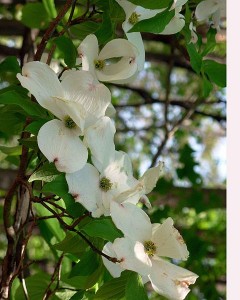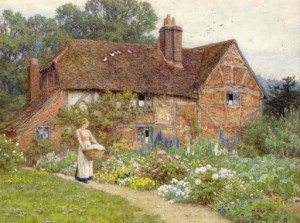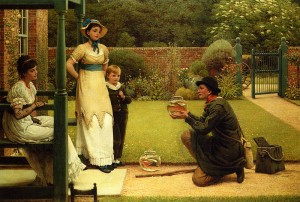 Janet’s and Myretta’s blogs and spring itself has me thinking about gardens. Spring in Virginia is at its most beautiful right now with the azaleas and dogwoods in bloom, the grass and trees a lush green and spring flowers popping up all over.
Janet’s and Myretta’s blogs and spring itself has me thinking about gardens. Spring in Virginia is at its most beautiful right now with the azaleas and dogwoods in bloom, the grass and trees a lush green and spring flowers popping up all over.
I just got back from California where my cousin had the most amazing garden with a hodgepodge of plants of all kinds and colors. It reminded me of an English cottage garden, although she had several succulents, which I imagine are not common in the English version. She also had a lemon tree that was filled with bright yellow ripe lemons.
 It is believed that the English cottage garden arose after the Black Death of the 1300s when land became available for small personal gardens of vegetables and herbs. Flowers were typically those that had medicinal properties. Certainly by the 19th century, farm workers kept cottage gardens where they could grow their own food. These personal gardens provided vegetables, and herbs and, increasingly, flowers for decoration.
It is believed that the English cottage garden arose after the Black Death of the 1300s when land became available for small personal gardens of vegetables and herbs. Flowers were typically those that had medicinal properties. Certainly by the 19th century, farm workers kept cottage gardens where they could grow their own food. These personal gardens provided vegetables, and herbs and, increasingly, flowers for decoration.
In the late 1800s such gardens became romanticised and more decorative than practical. Cultivating flowers as a hobby became more popular and eventually this sort of garden gained popularity in the United States.
 My cousin’s garden actually looks a bit similar to the one in this painting, The Goldfish Seller, by English painter Leslie George Dunlop (1835-1921). Of course, her house was a typical California ranch style, not a vine-covered brick cottage.
My cousin’s garden actually looks a bit similar to the one in this painting, The Goldfish Seller, by English painter Leslie George Dunlop (1835-1921). Of course, her house was a typical California ranch style, not a vine-covered brick cottage.
My garden is confined to a small space in front of our house, which I’m in the process of making more like an English garden. Right now my shrubs are tiny, and I need to plant some annuals, but I have gardenia bushes that I expect to bloom and a lilac bush with two blooms on it already. For me, who is so-not-a-gardener, this is a major achievement.
How does your garden grow?

I love English gardens of all sorts and would enjoy designing one. I think the cottage garden style can be adapted to a lot of different plants and climates. I’d even like doing the work, but I just don’t have enough time to devote to it.
When we first bought our house, I planted hundreds of crocuses. Now, due to depredation by squirrels and chipmunks, I have a few dozen. I planted tulips and the deer ate the blossoms right off, leaving the stems poking up naked and forlorn.
So now my gardening philosophy is “survival of the fittest”. Right now I have grape hyacinths and several types of daffodils. Later I rely on daylilies and Black-eyed Susans, both of which do well without a lot of care.
I just planted some day lilies and they are blooming with huge blooms!